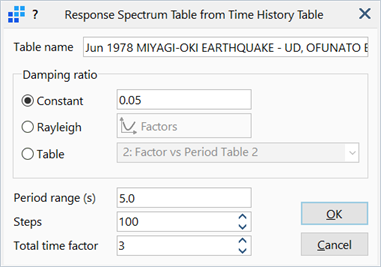Tables: Convert to Response Spectrum

Description
Converts the current Acceleration vs Time table into a corresponding acceleration response spectrum table and saves it as a new Factor vs Frequency/Period table.
The conversion is performed by applying the Acceleration vs Time table as a base acceleration excitation on a single degree of freedom system over a range of natural frequencies, solving for the time history response using the Newmark method, and recording the maximum response at each frequency (period). Frequency here refers to the frequency of the single degree of freedom system, not the excitation frequency; excitation is always the same Acceleration vs Time table.
Typically, recorded earthquake acceleration time history is converted into response spectrum for spectral response analysis.
Dialog
Damping ratio
The damping ratio, as the ratio of critical damping of a single degree of freedom system, specified in one of three ways.
-
Constant
Specifies the damping ratio as a constant for a single degree of freedom system of any frequency.
-
Rayleigh
The Factors button becomes available to open a SOLVERS Home: Rayleigh Damping dialog. The damping ratio of the single degree of freedom system then varies with frequency according to the specified Rayleigh damping definition.
-
Table
A dropdown list becomes available to select a Factor vs Frequency/Period table that specifies the relationship between damping ratio of the single degree of freedom system and its frequency/period.
Period range (s)
The upper limit of the period of the single degree of freedom system, in seconds. The acceleration response is determined for a range of single degree of freedom systems with a period ranging from 0.0 s to the specified upper limit.
Steps
The number of steps used to divide the period range. Acceleration responses are calculated at evenly spaced steps over the specified range.
Note that this parameter has no influence on the accuracy of the calculated points. It only affects the number of points calculated over the period range.
Total time factor
This is the ratio between the total simulation time of the single degree of freedom system and the total time for which the Acceleration vs Time table is defined. This option is provided to ensure that if the maximum response occurs after the end of the acceleration excitation, it can still be detected.
For example, if the Acceleration vs Time table defines a seismic event lasting 10 seconds, and the total time factor is set to 3, a total of 30 seconds of simulation time is used to find the maximum response of the single degree of freedom system at each frequency/period.
See Also